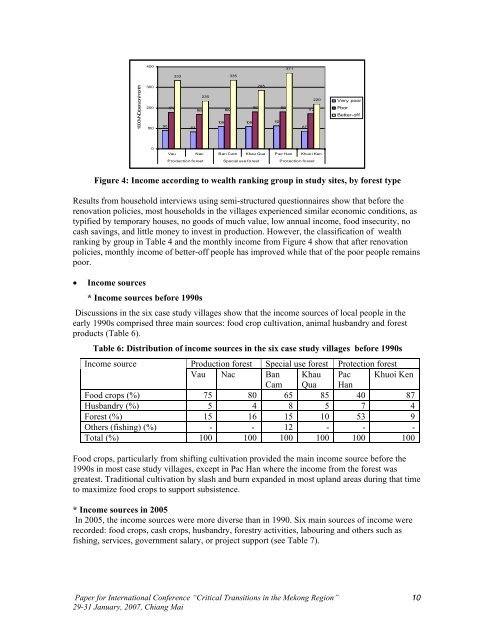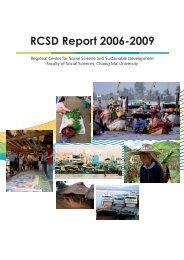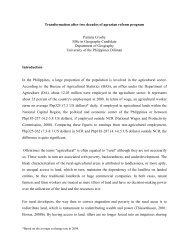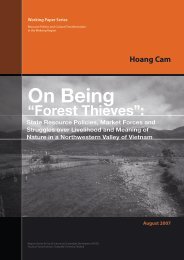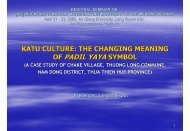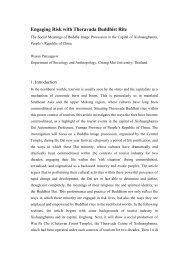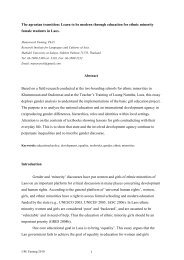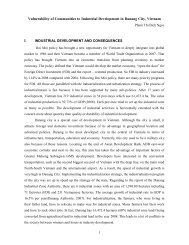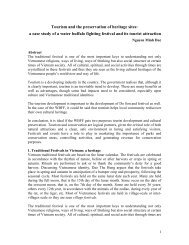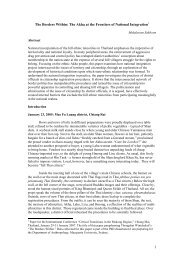The Impact of the Renovation Policies on the Livelihoods of ... - RCSD
The Impact of the Renovation Policies on the Livelihoods of ... - RCSD
The Impact of the Renovation Policies on the Livelihoods of ... - RCSD
You also want an ePaper? Increase the reach of your titles
YUMPU automatically turns print PDFs into web optimized ePapers that Google loves.
4003713333351000VND/pers<strong>on</strong>/m<strong>on</strong>th30020010090179285235168 169180 180108 108 1128387172220Very poorPoorBetter-<str<strong>on</strong>g>of</str<strong>on</strong>g>f0Vau Nac Ban Cam Khau Qua Pac Han Khuoi KenProducti<strong>on</strong> forest Special use forest Protecti<strong>on</strong> forestFigure 4: Income according to wealth ranking group in study sites, by forest typeResults from household interviews using semi-structured questi<strong>on</strong>naires show that before <str<strong>on</strong>g>the</str<strong>on</strong>g>renovati<strong>on</strong> policies, most households in <str<strong>on</strong>g>the</str<strong>on</strong>g> villages experienced similar ec<strong>on</strong>omic c<strong>on</strong>diti<strong>on</strong>s, astypified by temporary houses, no goods <str<strong>on</strong>g>of</str<strong>on</strong>g> much value, low annual income, food insecurity, nocash savings, and little m<strong>on</strong>ey to invest in producti<strong>on</strong>. However, <str<strong>on</strong>g>the</str<strong>on</strong>g> classificati<strong>on</strong> <str<strong>on</strong>g>of</str<strong>on</strong>g> wealthranking by group in Table 4 and <str<strong>on</strong>g>the</str<strong>on</strong>g> m<strong>on</strong>thly income from Figure 4 show that after renovati<strong>on</strong>policies, m<strong>on</strong>thly income <str<strong>on</strong>g>of</str<strong>on</strong>g> better-<str<strong>on</strong>g>of</str<strong>on</strong>g>f people has improved while that <str<strong>on</strong>g>of</str<strong>on</strong>g> <str<strong>on</strong>g>the</str<strong>on</strong>g> poor people remainspoor.• Income sources* Income sources before 1990sDiscussi<strong>on</strong>s in <str<strong>on</strong>g>the</str<strong>on</strong>g> six case study villages show that <str<strong>on</strong>g>the</str<strong>on</strong>g> income sources <str<strong>on</strong>g>of</str<strong>on</strong>g> local people in <str<strong>on</strong>g>the</str<strong>on</strong>g>early 1990s comprised three main sources: food crop cultivati<strong>on</strong>, animal husbandry and forestproducts (Table 6).Table 6: Distributi<strong>on</strong> <str<strong>on</strong>g>of</str<strong>on</strong>g> income sources in <str<strong>on</strong>g>the</str<strong>on</strong>g> six case study villages before 1990sIncome sourceProducti<strong>on</strong> forest Special use forest Protecti<strong>on</strong> forestVau Nac Ban Khau Pac Khuoi KenCam Qua HanFood crops (%) 75 80 65 85 40 87Husbandry (%) 5 4 8 5 7 4Forest (%) 15 16 15 10 53 9O<str<strong>on</strong>g>the</str<strong>on</strong>g>rs (fishing) (%) - - 12 - - -Total (%) 100 100 100 100 100 100Food crops, particularly from shifting cultivati<strong>on</strong> provided <str<strong>on</strong>g>the</str<strong>on</strong>g> main income source before <str<strong>on</strong>g>the</str<strong>on</strong>g>1990s in most case study villages, except in Pac Han where <str<strong>on</strong>g>the</str<strong>on</strong>g> income from <str<strong>on</strong>g>the</str<strong>on</strong>g> forest wasgreatest. Traditi<strong>on</strong>al cultivati<strong>on</strong> by slash and burn expanded in most upland areas during that timeto maximize food crops to support subsistence.* Income sources in 2005In 2005, <str<strong>on</strong>g>the</str<strong>on</strong>g> income sources were more diverse than in 1990. Six main sources <str<strong>on</strong>g>of</str<strong>on</strong>g> income wererecorded: food crops, cash crops, husbandry, forestry activities, labouring and o<str<strong>on</strong>g>the</str<strong>on</strong>g>rs such asfishing, services, government salary, or project support (see Table 7).Paper for Internati<strong>on</strong>al C<strong>on</strong>ference “Critical Transiti<strong>on</strong>s in <str<strong>on</strong>g>the</str<strong>on</strong>g> Mek<strong>on</strong>g Regi<strong>on</strong>”29-31 January, 2007, Chiang Mai10


